University drafts master plan in anticipation of growth
Neighborhood residents view elements of UP’s new master plan. The public information meeting was Tuesday in the Buckley Center. (Kate Peifer | The Beacon)
By Kate Peifer, Staff Writer -- peifer14@up.edu
At the end of May, UP will present the City of Portland with a new master plan that forecasts what UP might look like in 20 years. The plan anticipates needs of a potential student population of 5,000, a significant increase from the current population of 3,200 undergraduate students and approximately 700 graduate students.
The proposed snapshot of the plan is the first step to solidifying the 35-acre expansion of campus, including the River Campus below the bluff. Potential new projects include an environmental science laboratory, more student housing, additional parking, a shallow water habitat for juvenile salmon, softball fields and a track.
According to Assistant Vice President of Community Relations and Special Projects James Kuffner, the University is using the plan to gauge the future of UP's campus.
"We recognize that you can't predict what something will be like in 20 years but it gives you a benchmark to work with," Kuffner said.
The master plan will allow the University to meet the needs of the student population that has increased on average by 2.8 percent each year in recent years.
"We are able to measure the impact of a 3,800-student population and then measure an increase to 5,000 students to determine those impacts," Kuffner said. "We can then address this increase by adding parking, mitigating traffic and so forth to the needs that arise."
According to Kuffner, the plan was created to allow flexibility for the University's needs without designing specific buildings or arranged lots.
"We don't specify any particular buildings in order to be able to meet the needs of the growing population as needed," Kuffner said. "We can then select the project that is most needed and the University has always had the goal of residency on campus and new dormitories would be a part of any new development."
The master plan encompasses all uses related to the University including administrative, academic, recreational, residential and commercial.
"Considering all of the forced triples they've had to implement, it would make sense to add more dorms if they're going to expand," sophomore Liz Randazzo said.
The possible need for more residences on campus concerns surrounding neighbors, about two-dozen of whom attended an informational meeting in Buckley Center Tuesday night. Neighbor Stacy Mercer is concerned about the master plan since it allows buildings within campus to be up to 75 feet tall.
"I live on Warren, where my husband's father and grandfather built our house in 1948," Mercer said. "It's a family home so my concern is that I'll be staring at a giant door across the street."
According to Kuffner, some of the existing on-campus departments, such as athletic buildings, the baseball field, the tennis center and Physical Plant, will likely be relocated to the riverfront property.
"We obviously need a new athletic facility," sophomore Matt Brown said. "I had heard they might move the baseball fields down to the river and put a new gym where the fields are now. I think that would be ideal."
According to Kuffner, the timeline of development is uncertain.
"I don't know if there's a definite answer, but the growth of the campus and development of facilities is an ongoing process," Kuffner said. "We have developed a strategic plan that guides how the University sees itself and what it's offering to our students."
UP will present its case to the city, state why they are in compliance with all of the approval criteria and what steps they would take to alleviate any possible effects to the neighborhood.
"I will meet with those homes we don't own that are within the boundary lines to try to calm any fears or answer any questions they may have," Kuffner said. "And if there's some type of accommodation to exclude them from the boundary we will try to do that."
After the application is submitted, UP expects it to be reviewed and accepted or denied within five months. The overall budget of drafting the master plan is approximately $250,000.
The University's operational funding is paying for the drafting and designing of the plan, but any construction projects will rely on additional funding from donors.
The master plan will remain in effect until every initiative that is approved is completed.
"One of our main focuses is to maintain the nice, open and diverse campus we all know and love," Kuffner said.
Assistant Vice President of Community Relations and Special Proj- ects James Kuffner answers questions regarding UP’s master plan at the open house. (Kate Peifer | The Beacon)
Old School Boundary (Graphics courtesy of Soderstrom Architects)
Proposed school boundary (Graphics courtesy of Soderstrom Architects)








